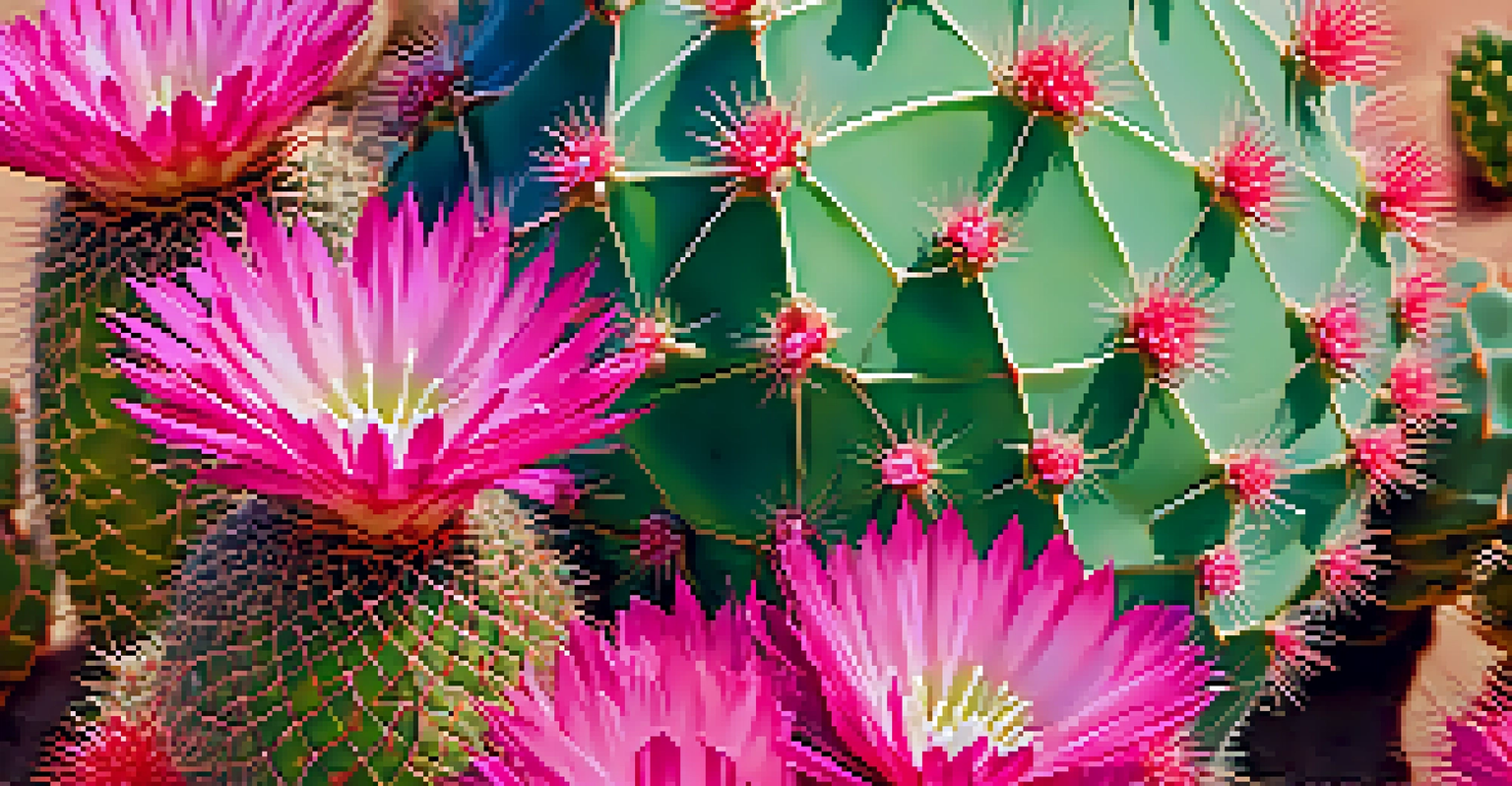Peyote's Role in Shamanic Traditions Across Cultures

Understanding Peyote and Its Cultural Significance
Peyote, a small cactus native to Mexico and the southwestern United States, has been used for centuries in various spiritual and healing practices. Known scientifically as Lophophora williamsii, it contains mescaline, a psychoactive compound that induces altered states of consciousness. For many Indigenous cultures, peyote is not just a plant; it's considered a sacred medicine that connects users to their spiritual beliefs and ancestral roots.
Psychedelics can facilitate profound healing experiences, particularly for mental health issues such as depression and PTSD.
The cultural significance of peyote can be seen in its use among Native American tribes, particularly in the context of ceremonies aimed at healing and divination. These ceremonies often involve communal gatherings where participants consume peyote to facilitate deep introspection and connection with the spirit world. This communal aspect fosters a sense of belonging and shared experience, which is central to shamanic practices.
In addition to its spiritual uses, peyote has also been a source of cultural identity for many tribes. It embodies a connection to their heritage and traditions, serving as a symbol of resistance against colonization and cultural erasure. This rich tapestry of meaning illustrates how peyote transcends its physical form, representing a bridge between the material and spiritual realms.
Peyote in Native American Church Practices
One of the most notable organizations utilizing peyote in its rituals is the Native American Church (NAC). Founded in the early 20th century, the NAC blends traditional Indigenous beliefs with elements of Christianity, creating a unique spiritual framework. Central to their practices is the sacramental use of peyote, seen as a vehicle for spiritual insight and personal transformation.

During ceremonies, participants often gather in a circle, sharing stories and singing songs that honor their ancestors and the spirit of the peyote. The experience is typically guided by a shaman or spiritual leader who facilitates the session, ensuring that the intentions of healing and connection are upheld. This structured approach allows participants to explore their inner selves while feeling supported by the group.
Peyote's Cultural Significance
Peyote is revered in Indigenous cultures as a sacred medicine that fosters spiritual connections and cultural identity.
The NAC has also played a crucial role in advocating for the legal rights of Indigenous peoples to use peyote in their spiritual practices. Legal battles have highlighted the importance of preserving these traditions against the backdrop of modern society, emphasizing that peyote is more than just a plant—it's a sacred element of cultural survival.
Peyote's Role in Mexican Shamanic Traditions
In Mexico, peyote has been a cornerstone of spiritual practices among various Indigenous groups, including the Huichol and Tarahumara. For these communities, peyote is seen as a gift from the gods, often referred to as 'the divine cactus.' The rituals surrounding its use are deeply intertwined with their cosmology and mythology, emphasizing the plant's role in connecting with the divine.
Peyote is not just a plant; it's considered a sacred medicine that connects users to their spiritual beliefs and ancestral roots.
Ceremonies often involve long journeys to sacred sites, where participants consume peyote as a means of gaining vision and insight. This pilgrimage-like approach reflects a profound respect for the land and the spiritual significance of the journey itself. The altered state induced by peyote encourages participants to engage with their surroundings in a new light, fostering a deeper understanding of their place within the universe.
Additionally, the experience of consuming peyote is often accompanied by artistic expressions, such as music, dance, and visual art. These creative outlets serve as a means of processing the insights gained during the experience, allowing for communal storytelling and the preservation of cultural narratives. This interplay between spirituality and creativity underscores the multifaceted role of peyote in Mexican shamanic traditions.
Psychedelic Therapy and Peyote's Modern Context
In recent years, there has been a resurgence of interest in psychedelics, including peyote, for therapeutic purposes. Research has indicated that psychedelics can facilitate profound healing experiences, particularly for mental health issues such as depression and PTSD. This modern exploration aligns with traditional uses of peyote as a healing agent, showcasing its potential benefits in contemporary society.
Therapists and researchers are increasingly recognizing the value of integrating peyote into structured therapeutic frameworks. By creating safe and supportive environments, individuals can explore their emotions and experiences with the guidance of trained professionals. This approach not only honors traditional practices but also adapts them to fit modern therapeutic needs.
Psychedelic Therapy Resurgence
Recent interest in psychedelics highlights peyote's potential therapeutic benefits for mental health, aligning with its traditional healing uses.
However, it's crucial to navigate this resurgence with respect for Indigenous traditions and the ecological sustainability of peyote. Overharvesting and habitat loss pose significant threats to peyote populations, prompting discussions about ethical sourcing and conservation. Ensuring that the benefits of peyote can be enjoyed by future generations requires a balanced approach that honors its cultural significance while fostering sustainable practices.
Comparative Shamanic Practices Involving Peyote
While peyote is most commonly associated with North American Indigenous practices, other cultures also utilize similar entheogenic plants in their shamanic rituals. For example, the Amazonian ayahuasca ceremonies offer a parallel experience, where participants consume a brew made from the ayahuasca vine and other plants. Both peyote and ayahuasca facilitate altered states of consciousness, allowing individuals to connect with their spirituality.
In many ways, these practices serve similar purposes: healing, introspection, and connection to the spirit realm. The communal aspect is also prevalent in both traditions, where individuals gather to share their experiences and insights, fostering a collective sense of understanding and healing. This highlights a universal thread that runs through shamanic practices worldwide, emphasizing the human desire for connection and meaning.
However, the specific cultural contexts and the plants used vary significantly, showcasing the diversity of shamanic practices. Understanding these differences can enrich our appreciation for the various ways humans have sought to connect with the divine and navigate their inner landscapes throughout history.
Legal and Ethical Considerations Surrounding Peyote
The legal status of peyote is complex and varies by country, often reflecting broader societal attitudes toward psychedelics. In the United States, for example, peyote is classified as a Schedule I controlled substance, which means it's illegal for general use. However, exceptions exist for members of the Native American Church, who are allowed to use peyote in their ceremonies, highlighting the ongoing tension between cultural practices and legal frameworks.
This legal ambiguity raises important ethical questions about access and cultural appropriation. As interest in psychedelics grows, it's essential to ensure that Indigenous communities retain their rights to these sacred plants. Respecting the cultural heritage and spiritual significance of peyote is paramount, especially as outsiders seek to engage with its powerful effects.
Legal and Ethical Challenges
The complex legal status of peyote raises ethical concerns about access, cultural appropriation, and the need for sustainable practices.
Moreover, the commercial exploitation of peyote threatens both its ecological viability and the authenticity of Indigenous practices. Ensuring that the benefits of peyote are accessible to those who have traditionally used it requires ongoing dialogue and collaboration between Indigenous communities, researchers, and policymakers.
Conclusion: The Enduring Legacy of Peyote in Shamanism
Peyote continues to hold a significant place in shamanic traditions across cultures, serving as a bridge between the physical and spiritual realms. Its use in ceremonies fosters healing, introspection, and connection, providing a valuable tool for those seeking deeper understanding of themselves and their place in the world. Through its rich history, peyote embodies the resilience of Indigenous cultures and their ongoing connection to the land.
As modern society grapples with mental health challenges, the lessons from peyote's traditional uses become increasingly relevant. By integrating these ancient practices with contemporary therapeutic frameworks, we can honor the wisdom of Indigenous peoples while also exploring new avenues for healing. This symbiotic relationship can ultimately enrich both individual experiences and cultural understanding.

In navigating the future of peyote's role in shamanism, it's essential to prioritize ethical considerations and sustainability. By working collaboratively with Indigenous communities and respecting their rights, we can ensure that the legacy of peyote endures, continuing to inspire and heal generations to come.